Almost exactly 10 years after my first visit, I have finally made it back to Japan. Call me a basic bitch, but like so many other people, it’s one of my favourite places in the world. And whilst 18 days there wasn’t nearly enough, I did use this time to get some serious eating done. Some of it is Michelin-recommended (though none of them are Michelin-starred – I prefer to spend my time abroad exploring local cuisine that I can’t get back home), some of it is internet-famous, and a lot of it is just tasty-looking things I happened to run across. And with Japan being what it is, almost all of it is delicious. And don’t even get me started on the konbini (convenience store) food – iykyk, and I could start a whole other blog reviewing its many delights.
Iruca Tokyo Roppongi
4 Chome-12-12 Roppongi
Minato City, Tokyo, 106-0032
Alright, now we’re getting to the big guns. Iruca Tokyo Roppongi came highly recommended by the Michelin guide for its fresh take on traditional ramen. And though I’m usually relatively conservative when it comes to my noodles, I will admit that this is the most elegant bowl of ramen I’ve ever had. Each element was absolutely exquisite, every morsel carefully balanced against the others in flavour, texture, and even appearance. The restaurant itself is also gorgeous, more like a high-end izakaya than a ramen shop. But all that goodness doesn’t come easy – it’s a one hour wait if you show up about half an hour before opening, though the line doesn’t seem to get too much longer than that. It’s definitely worth checking out, as it’s something you definitely won’t be able to get in Australia (and I’ll wager, most places outside of Japan). Just make sure you DON’T come hungry, because there will definitely be a wait.
Rating: 14.5/20 – exquisite ramen.
To-order: just go with their flagship shoyu porcini and yuzu ramens – they’re the 1st and 2nd best-sellers for a reason. but if you’re flying solo, I prefer the shoyu porcini for taste, though the yuzu might be preferred for something a little more out of left field.

Special Porcini Shoyu Ramen (1800 yen)
You can smell the Special Porcini Shoyu Ramen (1800 yen) before you see it. The stock initially comes out all dark and smoky, with just a hint of earthy musk. Stir in that extra spoonful of porcini however, and what you get is a deep umami bomb, which despite the added richness, remains inexplicably balanced in flavour. The accompanying toppings are the quality of which you’d get at a fine dining restaurant – slices of blushing sous vide charshu with a black pepper crust; slices of poached chicken so delicate you wonder for a moment if it’s tofu; rustic yet delicate meatballs, one chicken and one clam; and one of the creamiest eggs I’ve ever had. Even the scallions are perfect: green and crisp like salad leaves, with a hint of bite but no pungency. The slightly flat, medium-thick noodles are flawless – but that goes without saying.

Special Yuzu Shio Ramen (1800 yen)

Special Yuzu Shio Ramen (1800 yen)
What hit me about the Special Yuzu Shio Ramen (1800 yen) was not the smell of the stock, but how clear it was. Stir the yuzu paste through, and what you have is a light yet flavoursome stock, imbibed with the summery, slightly astringent aroma of yuzu. It’s an unexpected combination, but one sip and you’ll wonder why no one else has thought of this – it just seems so natural. What I found almost as interesting as the unorthodox flavour is how the toppings, which worked so well in the earthy shoyu broth, were just as apt in this ephemeral citrus concoction.

Truffle Egg Over Rice (400 yen)

Truffle Egg Over Rice (400 yen)
It’s not uncommon to get a rice bowl to go with your ramen in Japan, and because I had forsaken brunch the other day at a specialty bonito shop, I leapt on the Truffle Egg Over Rice (400 yen). This is the epitome of what Japan does so well – taking the highest quality ingredients and just letting them shine. Like the ramen, every element of this bowl is perfect. The plump fluffy rice and briny bonito flakes, robed with dark orange yolk, was the most elegant of comfort foods.
Fuunji Ramen
2-14-3 Hokuto Daiichi Building 1F
Yoyogi, Shibuya, 151-0053
Unlike Iruca, Fuunji Ramen very much deals in tradition. Think collagen-laden tonkotsu soup, almost thick enough to stand a spoon in, accompanied by hearty serves of noodles and fatty slow-cooked pork. Iruca may be more refined, but this is definitely much more viscerally enjoyable, in the same way a juicy, fatty cheeseburger sometimes will trump the fanciest of sandwiches. DO come hungry for this one; there may be a wait (about half an hour at opening), but you will end up so weighed down with carbs and pork fat that you can probably skip the next meal.
Rating: 15/20 – visceral pleasures.
Go-to: tsukemen.

Special Tsukemen (1150 yen)
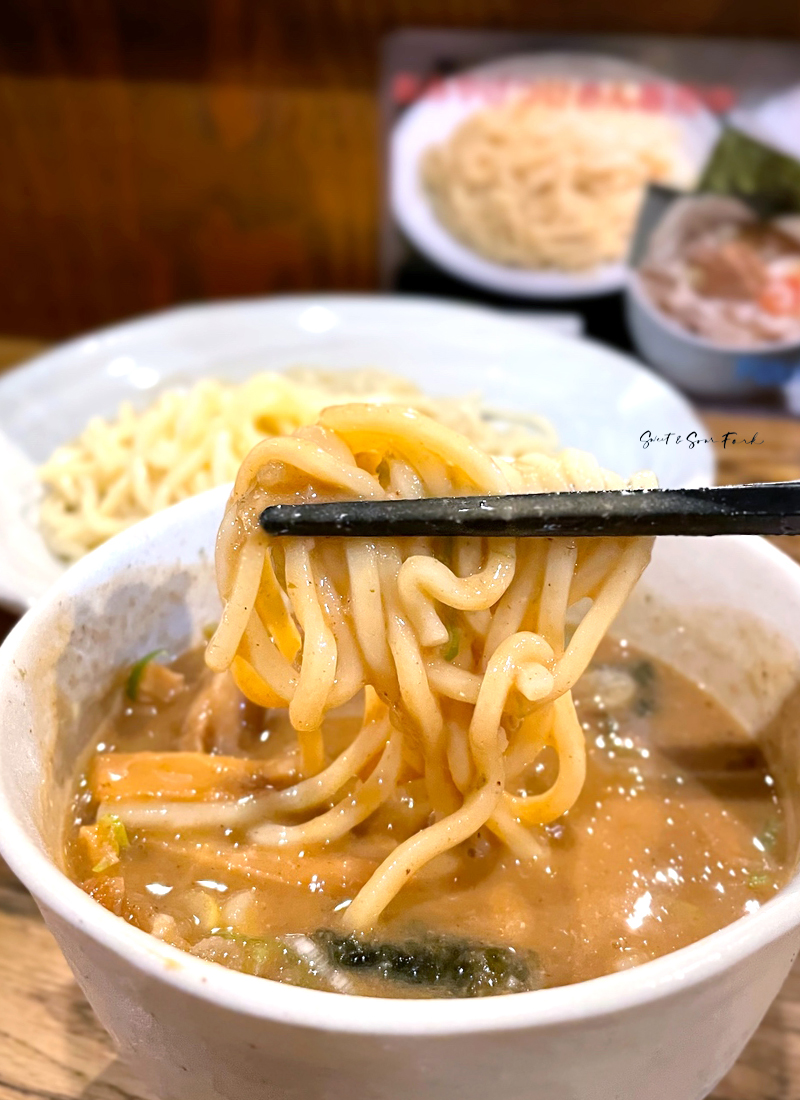
Special Tsukemen (1150 yen)
The Special Tsukemen (1150 yen) ranks among the top 5 things I ate on this trip. The thick, chewy noodles, eaten after a quick dunk into the unctuous pork soup is just pure pleasure. A scoop of bonito powder on top, mixed through the stock, adds loads of umami, and just a hint of sweetness to balance out the fat and salt. And the fun doesn’t stop there – hidden beneath the surface are all sorts of treasures, including fatty charshu, crunchy bamboo, and the essential freshness of scallion.

Special Ramen (1100 yen)
Equally as indulgent is the Special Ramen (1100 yen), which is made in the same mould as the tsukemen. The main difference is that the soup is lighter (though I hesitate to even say that, given it’s miles richer than anything I’ve ever had in Melbourne), making this the preferred option for those who also want to drink their soup. But if you ask me, nothing beats the concentrated flavour of the enriched tsukemen stock, clinging to the thick noodles.
Tempura Kakiage Yukimura
6-13-13 Shimbashi
Minato-ku, Tokyo, 105-0004
Despite being on the Michelin guide, Tempura Kakiage Yukimura is still a relatively hidden gem. There are no queues, and a lot of diners seem to be locals and regulars. But this was one of, if not the most enjoyable meal I’d had on this trip. The food here is simple and delicious, showcasing tempura as something simultaneously rustic yet elegant. It’s hard to say why this place is so special; yes the ingredients and execution are both meticulous, but that’s not really all that unique in Japan. There’s just a certain je ne sais quoi about the food here that makes me long to come back. Not to mention, the service is so warm and accommodating that I felt the urge, multiple times, to call the owner granny.
Rating: 16/20 – dish of the trip (???)
Best dish: kakiage bowl. and be greedy, get a double serve of tempura. I still wish I did.
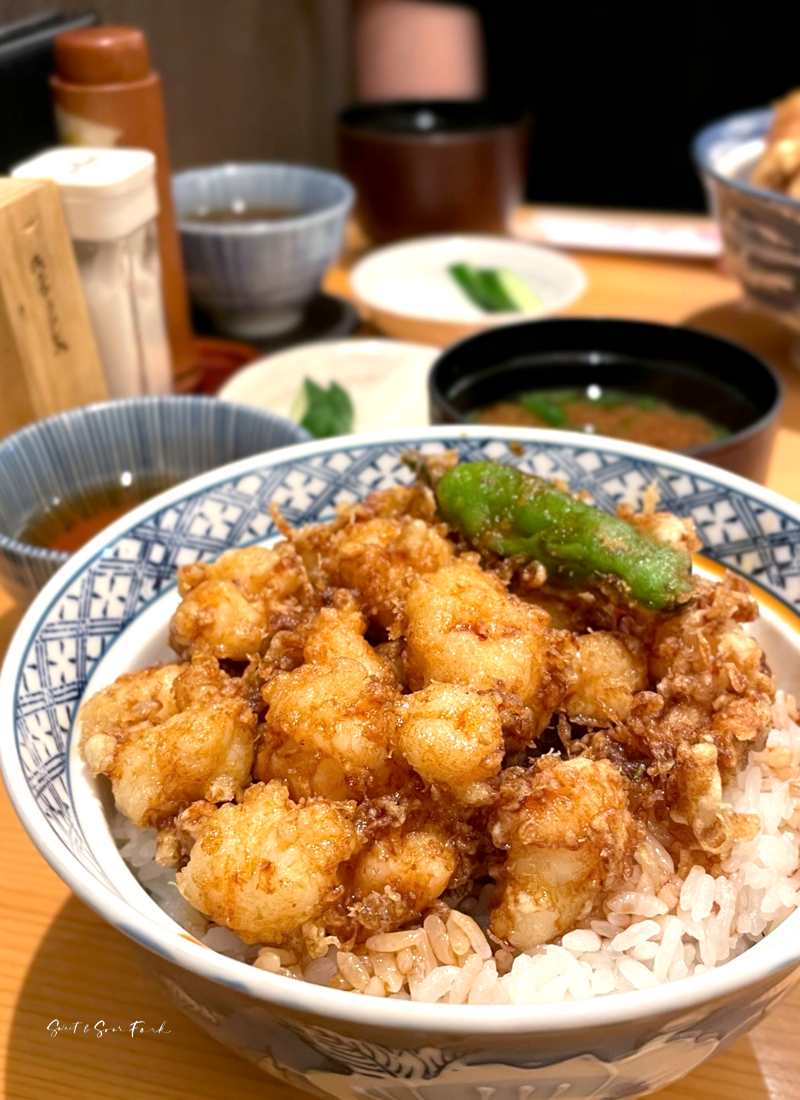
Kakiage Bowl (1400 yen)
The Kakiage Bowl (1400 yen) is SO SO GOOD, and well more than the sum of its parts. The chunks of bouncy prawn, lightly fried in ethereal batter, then served doused in sweet soy sauce on a bed of fluffy white rice is a wondrous juxtaposition of high and low. The deep frying and carbs, combined with the lacy crunch and delicate seafood, satisfies multiple cravings at once. On the side are house-made pickles with just enough crunch and astringency to cut through the fat, and cleanse the palate for a sip of the aromatic clam miso soup.

Tempura Bowl Special (1900 yen)
If you want tempura in a more familiar format, then go for the Tempura Bowl Special (1900 yen), which comes with an additional piece of your choice. I had heard good things about the conger eel, and it was indeed buttery with a mild flavour. The prawns were also excellent, but I daresay I preferred them cut up like in the kakiage bowl, so as to maximise the batter-seafood ratio. My favourite of the lot would have to be the melt-in-the-mouth cuttlefish, though the lightly spiced piece of pumpkin was a close second.
Kanda Matsuya
1 Chome-13 Kanda Sudacho
Chiyoda City, Tokyo, 101-0041
Another hidden gem is Kanda Matsuya. An easy 10-minute walk from the bustle of Akihabara, this is where the locals go for traditional, and very excellent soba. It’s easy, it’s delicious, and it’s just the thing for a hot summer day.
Rating: 14/20 – perfecto soba.
Fun fact: I wandered off in one of the giant electronics shops in Akihabara at one point, and chris decided that ‘I lost my gf in akhiba’ would be a great song title.

Morisoba (825 yen)
When in doubt, go for the Morisoba (825 yen) – the classic of fresh noodles, dipping sauce, and spring onions. This is simple perfection at its best, the chewy soba light and refreshing, yet full of flavour, once dunked into the savoury cold broth. If you ask me, the best way to have it is to add some spring onions and shichimi powder into the stock, and enjoy the added freshness and smoky warmth with each bite of noodle. And after you finish the noodles, don’t forget to wait for the staff to give you a pot of the soba cooking water, so you can mix it in with the remainder of the stock, and sip it down like a soup.

Okamesoba (1375 yen)
The warm options here are also excellent – the Okamesoba (1375 yen) is elegant and nourishing, with a very clean umami courtesy of the combination of mushrooms and nori. Although it’s warm, the delicate flavours means that it’s just as suitable for summer as it is for winter.
Soba Toriyaki
8 Chome−2−Tokyo Expressway Yamashita Bld.
Ginza, Chuo City, 104-0061
We were wandering around Ginza one night, looking for something to eat. It turns out that if you want to eat in Ginza on a weekend, you’d better have a booking, or you’d be looking at an hour wait (minimum) no matter where you go. And so it went at Soba Toriyaki, a new-ish restaurant in the area where the name says it all – soba and BBQ chicken. The food here wasn’t all that special, though in its defence, we only had the soba, whereas most people seemed to be taking advantage of the grill. They also had these weird private booths, which were kind of nice, but also way too enclosed once the doors were slid shut. All in all, I didn’t love this place, but it was alright for a quick meal.
Rating: 11.5/20 – just ok.
To-order: BBQ chicken, maybe??

Shrimp Tempura Soba (1518 yen)
Compared to Kanda Matsuya, the Shrimp Tempura Soba (1518 yen) was hella ordinary, and pretty expensive. The soup just didn’t have the same depth of flavour, and was a smidge over-salted. The tempura though was excellent, with a light, greaseless batter.
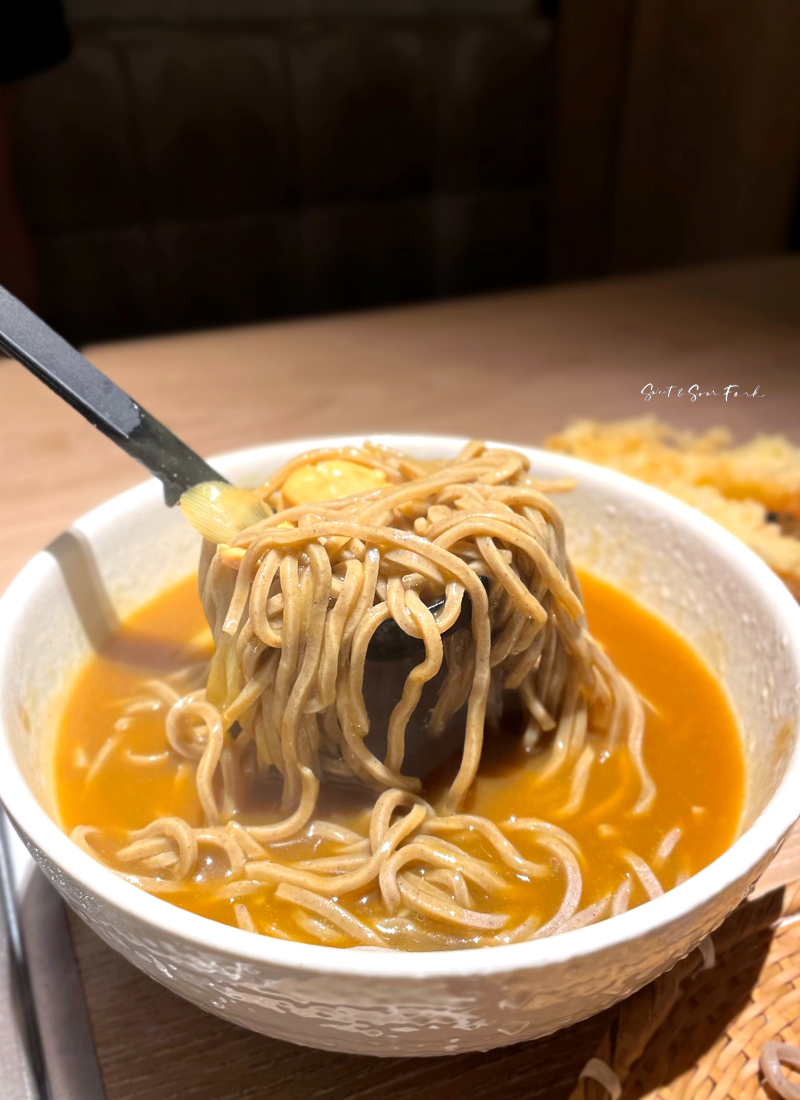
Curry Soba (1298 yen)
Similarly, the Curry Soba (1298 yen) was uninspired. There wasn’t enough chicken in the soup, which in turn, was just average.
Joto Curry Shibuya
3-18-7 1F Shibuya Higashi 1st Bldg.
Shibuya, Tokyo, 150-0002
Now we get to the curries. To me, a good curry house is almost the Japanese equivalent of an American diner – a rustic no-frills place, usually family-run, serving up gargantuan platters of gut-busting curry. And that’s exactly what Joto Curry Shibuya is. Warm and wood-panelled, this retro little hole-in-the-wall is filled with hungry punters, chowing down on a day’s worth of calories in curry form. The food is simple but sensational, the giant vat of gravy slowly bubbling away in a next to an equally enormous pot of rice. Sure, it’s not gourmet, but it’s about as good as comfort food gets.
Rating: 14.5/20 – how good is this.
Ok, here’s the secret: Joto Curry is actually part of an Osakan chain, but you absolutely would not know it. The 40-year-old recipe tastes as homemade as anything.

Tonkatsu Curry (990 yen, regular)
Is there anything as good as Tonkatsu Curry (990 yen, regular)? I should think not. The contrast of the juicy cutlet and crunchy crumbing, the way the curry sauce soaks into the mound of rice, and the crunchy pickles cutting through the richness – there is truly nothing better. The gravy is lusciously thick, medium-spicy, and has just a hint of fruity tang. The portion was large, but you’d better believe it was all hoovered up.

Spinach Curry (990 yen, regular)
The veg situation in Japan really is dire: case in point, my Spinach Curry (990 yen, regular) cost the same as the tonkatsu option. If you ask me though, its worth it to get that bit of greenery in, and once we swapped some of the spinach for the tonkatsu, ended up with an almost-balanced-ish meal.
Hinoya Curry Akihabara
1-8-11 Sotokanda
Chiyoda-ku, Tokyo, 101-0021
Hinoya Curry Akihabara is another well-known chain to get your curry on. Though it ultimately comes down the personal preference, I think I like the sauce here just a smidge more than Joto curry. On the flip side, Hinoya definitely loses out in terms of atmosphere, trading the homely diner feel for a more sterile, eat-and-run vibe. Ultimately though, they both do a cracking curry, and I would be delighted to eat at either.
Rating: 15/20 – curry champ.
Good to know: if you really want to go all-out, Hinoya would be the better choice. you can add everything from fried pork belly, to broiled bacon, to garlic butter, to an entire mound of shredded cheese on top.
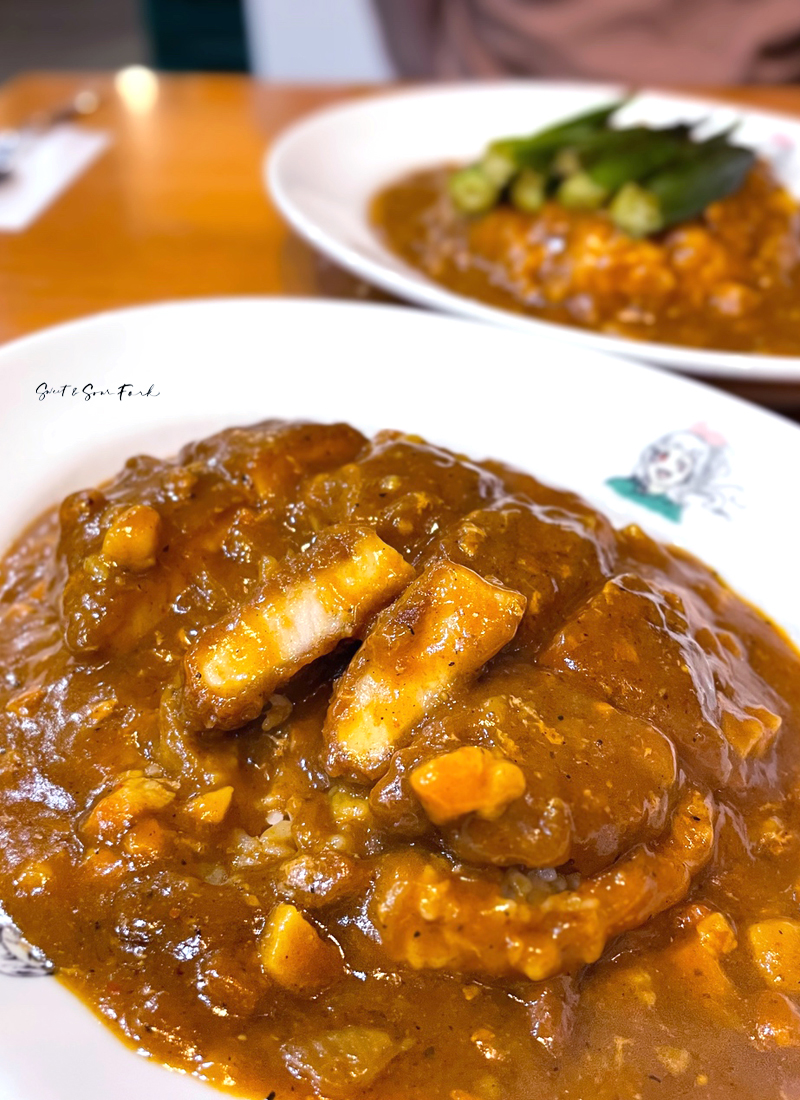
Tonkatsu Curry (1100 yen)
Once again, this is the good stuff – fried pork, sauce, and loads of rice, aka Tonkatsu Curry (1100 yen). The gravy here is slightly darker and chunkier, with a meatier flavour and a touch more spice. I really loved the way the tangy pickles contrasted against this richer sauce.
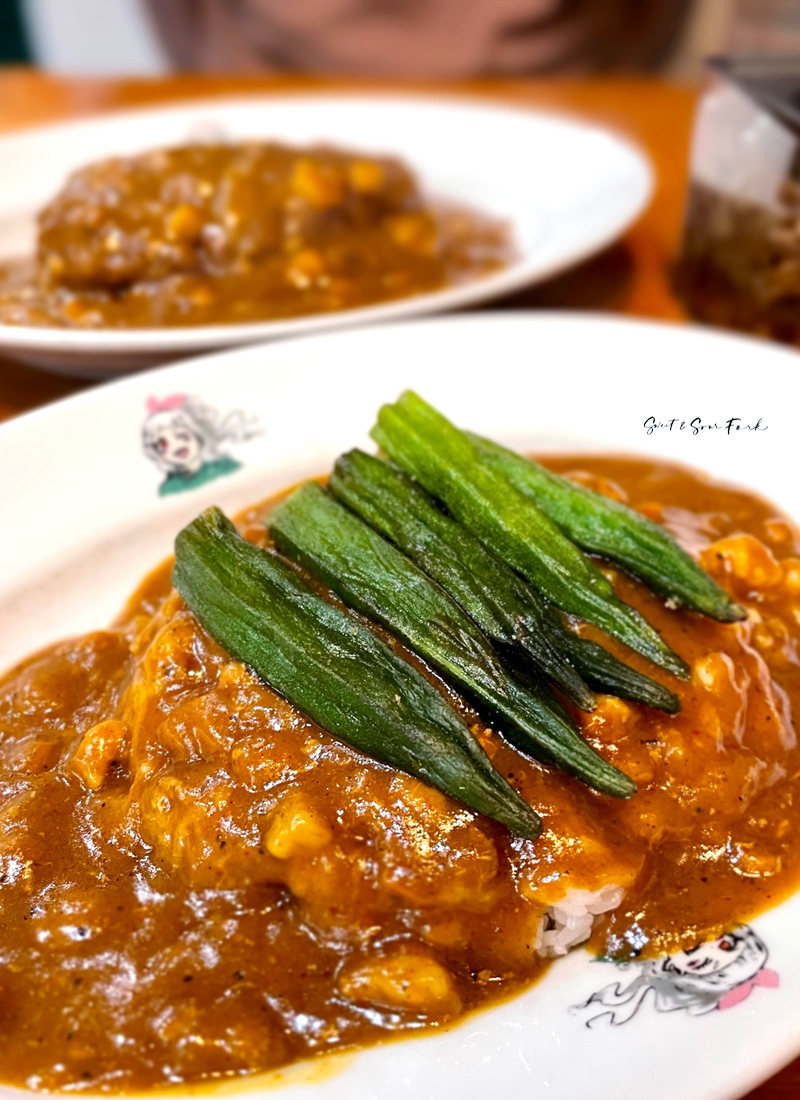
Okra Curry (950 yen)
No spinach here! Instead it’s the Okra Curry (950 yen) for your veg fix, even if it does come blistered from the deep fryer. The crunch is a great accompaniment to the saucy rice.
Yakitori Ton Ton
2 Chome-1-10 Yurakucho
Chiyoda City, Tokyo, 100-0006
Yakitori Ton Ton is our first food stop after we arrived in Tokyo, and although it’s probably not THE best yakitori, the atmosphere is impeccable, and a great way to immerse ourselves in the city. Located in a smoky underpass, this place is cramped, bustling, and has good times written all over it. There’s no cover charge, but you are required to order one of the (very affordable) drinks – no hardships there when the meal largely consists of salty meaty bits. For once, I’d actually say it’s worth coming here more for the experience than the food.
Rating: 14/20 – passing the vibe check.
Good to know: the mandatory drink order also includes soft drinks!
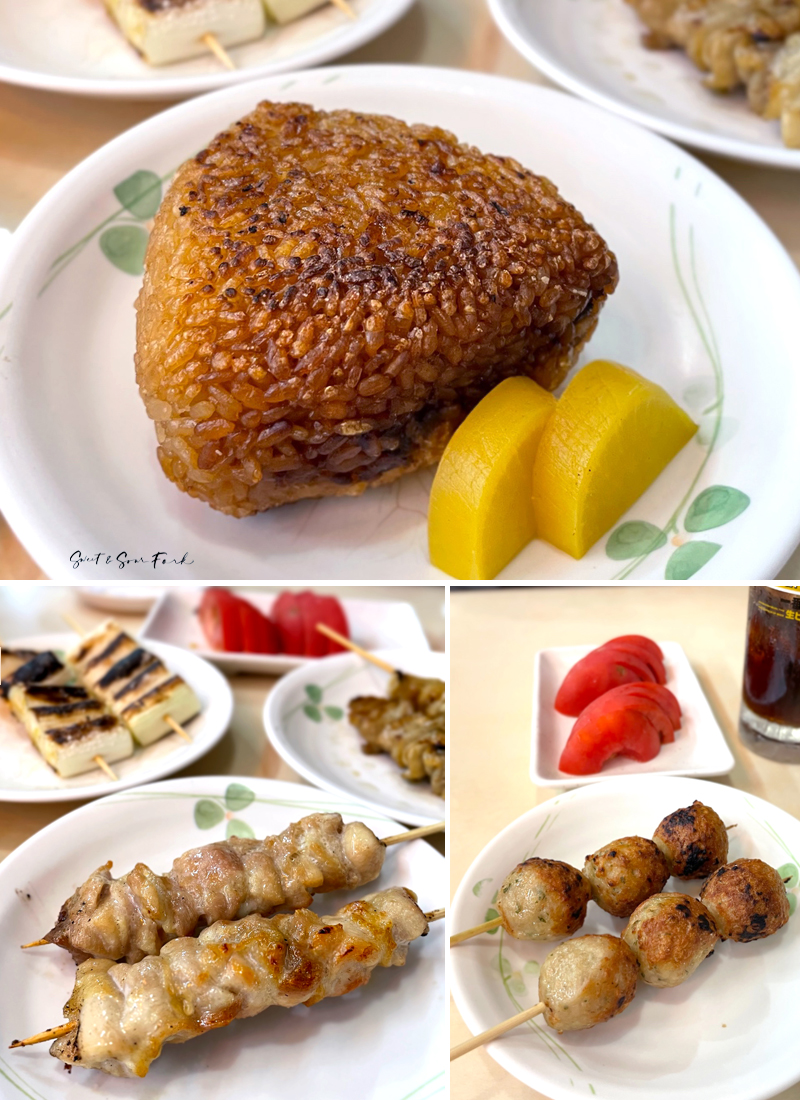
Yaki Onigiri (360 yen/ea) | Yakitori (190 yen/ea) | Tsukune (190 yen/ea)
As far as the skewers go, it’s hard to go past the original Yakitori (190 yen/ea). The chicken thigh was juicy and tender, and infused with smoky, savoury flavours from the charcoal. The Tsukune (190 yen/ea) is also a good pick, the chicken meatballs being a great crowd pleaser, and really yummy with the shichimi powder. And now for a slightly more unexpected one – the Yaki Onigiri (360 yen/ea) is a nice little filler option, the rice ball grilled until slightly crisp, and the soy glaze releasing notes of earthy caramelisation.
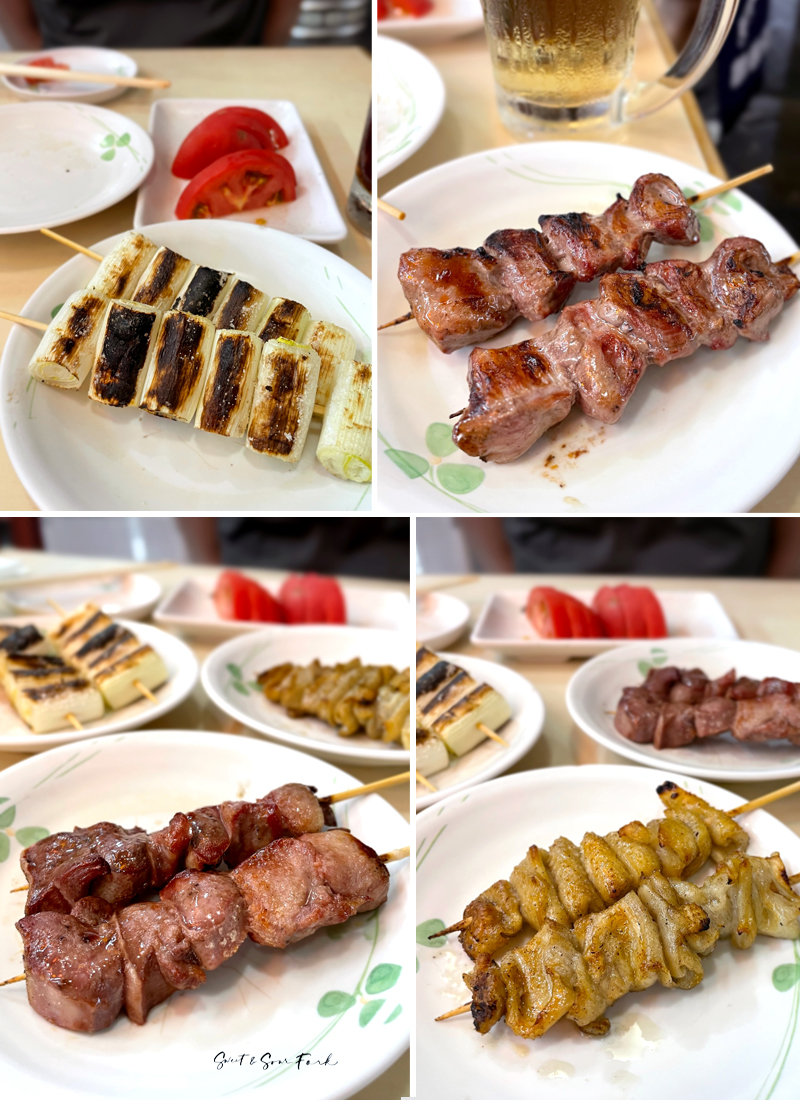
Negi (170 yen/ea) | Harami (190 yen/ea) | Tan (190 yen/ea) | Kawa (190 yen/ea)
The other skewers we had were also good, but not amazing. The Harami (190 yen/ea) was predictably indulgent, as you tend to get with fatty cuts of pork. The Kawa (190 yen/ea) was also tasty, but the chicken skin could’ve done with a bit more time on the grill to render the fat into crispy edges. The Tan (190 yen/ea) was alright, though the ox tongue could be more tender and smoky, and the Negi (170 yen/ea) was a good palate cleanser, the leek releasing its sweetness on the grill. Just don’t get the Hiyasii Tomato (460 yen) – a dish of chilled tomato which is very literally a cold tomato cut into slices. And it’s not even a good tomato. If you want something cold, then stick to the Plum Sour (460 yen) or Cola Sour (460 yen) or something; at least that way you get more bang for your buck.
Tsukiji Market
The business end of Tsukiji Market may have moved to Toyosu, but the bit that most tourists care about – the outer market with all the food and produce – still remains intact at Tsukiji, with the exception of a few select sushi restaurants. Yes, this area is packed-as, and there are definitely some tourist traps (PSST, do not get the fruit skewers). But all up, it is such a cool place to visit, with so many unique food options, not to mention the opportunity to gorge on seafood. Unless you are desperate to avoid crowd at all costs, Tsukiji is definitely worth a visit.
Tsukiji Kagura Sushi Honten
4 Chome-14-13 Tsukiji
Chuo City, Tokyo, 104-0045
I had no interest in getting up at 4am and lining up for 3 hours to eat at one of the ‘famous’ sushi spots in Tsukiji Market; I figured that most places are probably created fairly equal anyway, as long as the reviews were good, and it didn’t look like part of a chain. So after wandering around the market some, I came across Tsukiji Kagura Sushi Honten, an absolutely miniscule spot hidden under an awning. I then proceeded to chow down on the most exquisite plate of nigiri for a fraction of the cost you’d usually expect to pay. I’m definitely feeling smug about this one – I dodged the queues and the early wakeup.
Rating: 15/20 – as good as the rest.

Zeitaku (2970 yen)
Anyway, onto the sushi. Because Chris is lukewarm about sushi at best, I ended up eating here myself, and so had to restrict my ordering so as to leave room for other things I wanted to eat at Tsukiji. The Zeitaku (2970 yen) was what I ended up getting, which consisted of 9 pieces of nigiri, a tuna hand roll, and an egg omelette, along with a lovely bowl of miso soup. As I had hoped, every single piece was exquisite, and my favourites included the sticky sweet prawn, the briny cream of the sea urchin, and the most wildly buttery piece of fatty tuna. I was also a fan of how they did their rice – fluffy but with still a little chew, slightly heavier on vinegar and not too sweet, and falling apart just the right amount once it hits the mouth. This was showcased especially well in the tuna hand roll, where the rice was allowed to take more of a leading role, accompanied by the nutty nori, light richness of the minced tuna, and a touch of fresh wasabi.
Kitsuneya
4 Chome-9-12 Tsukiji
Chuo City, Tokyo, 104-0045
The other Tsukiji Market must-have was not seafood, but Kitsuneya – a purveyor of horumon-don for almost 80 years. Now, don’t be squeamish; this may be offal stew, but texture-aside, could be the most succulent, slow-cooked beef. The queue for this is also long, but given that there is standing room only, the wait only ends up being only about 20 minutes – plenty of time to digest whatever else it is you’ve eaten before this.
Rating: 15/20 – horumon is not horuble.
What to get: horumon-don, obvs. and if you’re really hardcore, you can top it with a soft-boiled egg. just don’t expect to need to eat again for about 12 hours.

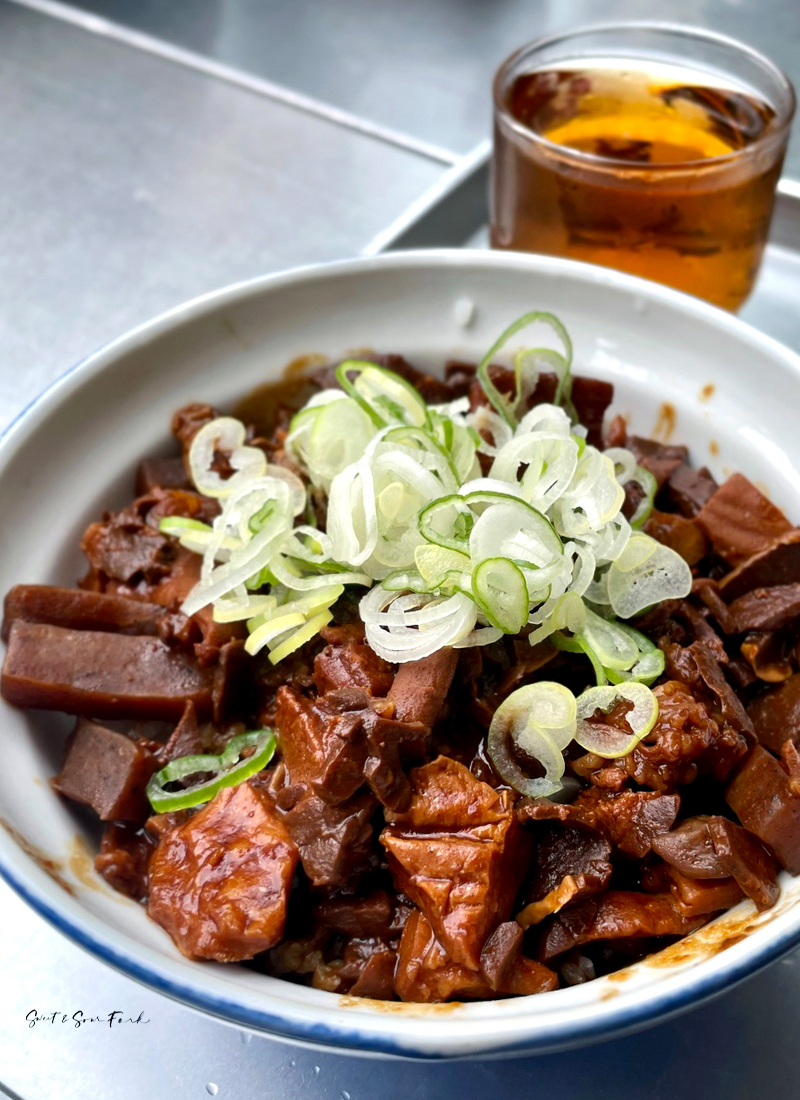
Horumon-Don (900 yen)
Bubbling away darkly on the stove, you can tell how flavoursome the Horumon-Don (900 yen) is going to be before even the first taste. Slow-cooked in chocolatey hatcho miso, the stew has the deep, earthy richness you can only get from offal. The chewy-tender texture of the beefy bits contrasts beautifully with the fluffy bed of rice, and before long you’ll be grateful for the clarifying properties of the spring onion, because this stuff is heavy, even for the most determined of stomachs. Make sure you take advantage of the strong black tea as well.
Other bits and bobs

Tamago (150 yen)/Strawberry Grape Skewer (600 yen)
Rounding out the list of popular things to eat at Tsukiji is the Tamago (150 yen) at Yamacho. Made fresh to order, this layered omelette is so custardy it’s in danger of falling off the skewer. Combined with the sweetness, it has an almost dessert vibe to it. There are obviously better things to have at the market, but if you’ve never had a good Japanese omelette before (or heck, even if you have), it’s worth trying. DO NOT however, get the Strawberry Grape Skewer (600 yen). I thought this would be an affordable way to try some of Japan’s notoriously pricy fruits but nope, these barely edged out what you can get in the supermarkets here. The strawberries I at least sort of get because it was late-ish in the season, but it was peak muscat grape season when I visited, so they have no excuse.
Parfaiteria Bel
Shintaiso Social Bldg 3F, 1-7-10 Dogenzaka
Shibuya, 150-0043, Tokyo
Japan loves parfait desserts. I imagine it’s a combination of the gorgeous presentation, as well as fruits being something of a luxury item. Parfaiteria Bel seemed like one of the more popular ones, so on our obligatory trip to Shibuya, I decided to search it out. I say search it out and I mean it – with only a tiny sign to guide you up 3 flights of stairs in a non-descript building, you really have to know what you’re looking for. But once you brave the dodgy stairwell, you’re rewarded with a rabbit warren of coziness, as well as a menu of the most exquisite and delicate desserts. Now, given their one item per person policy, eating here gets pretty pricey – we’re looking at about $30 AUD each just for dessert. So of course, the question is this: is it worth it? I’d say… sort of. I can definitely see why everything costs so much; the sheer number of unique elements in each glass, as well as the peerless presentation, definitely justifies the cost. However, I found they didn’t taste quite as good as they looked, and would probably only eat here again if someone else was paying.
Rating: 13/20 – a pretty face.

Fig Parfait (2180 yen)
Isn’t this Fig Parfait (2180 yen) just stunning? I can easily say I’ve never seen a more beautiful dessert. Layered into the glass is a variety of full-bodied elements, including chocolate gelato with amaretto, caramelised walnuts, roasted tea jelly, savoury pie, and chocolate genoise. Combined with the jammy sweetness of the fig, the result is a luxuriously dark and sophisticated dessert that brings to mind leather armchairs and roaring fireplaces.

Night of the Full Moon (2480 yen)
On the lighter end is the Night of the Full Moon (2480 yen), which is a Mid-Autumn Festival special. The fruitier flavour comes from mandarin sorbet, persimmon mousse, and bergamot marshmallow, and its blended together in a milky base of almond mild panna cotta, tofu mochi, and milk gelato.
Ginza Sembikiya
5 Chome−5−1 1F, Ginza
Chuo City, 104-0061, Tokyo
https://www.ginza.jp/en/shop/845
A more traditional, and less avant-garde option for parfaits is Ginza Sembikiya. A longstanding (we’re talking since 1894!) specialty fruit purveyor, they also have a couple of cafes in central Tokyo that turns their fancy fruits into desserts. Not only do they have layered parfaits of fruit and creamy things, they also do fruit plates with traditional Japanese sweets, as well as fruit sandwiches and cakes. Now, I’ve still yet to work out whether I’m just eating the wrong things, or we’re very lucky in Australia (or maybe they’re really unlucky in Japan!), but the fruits here I would say are just on par with a better-than-usual haul from Woolies. Eating a bunch of fruit and ice cream in a tall glass is always fun, but I think I might just start doing this at home instead.
Rating: 12/20 – not so fancy fruit.
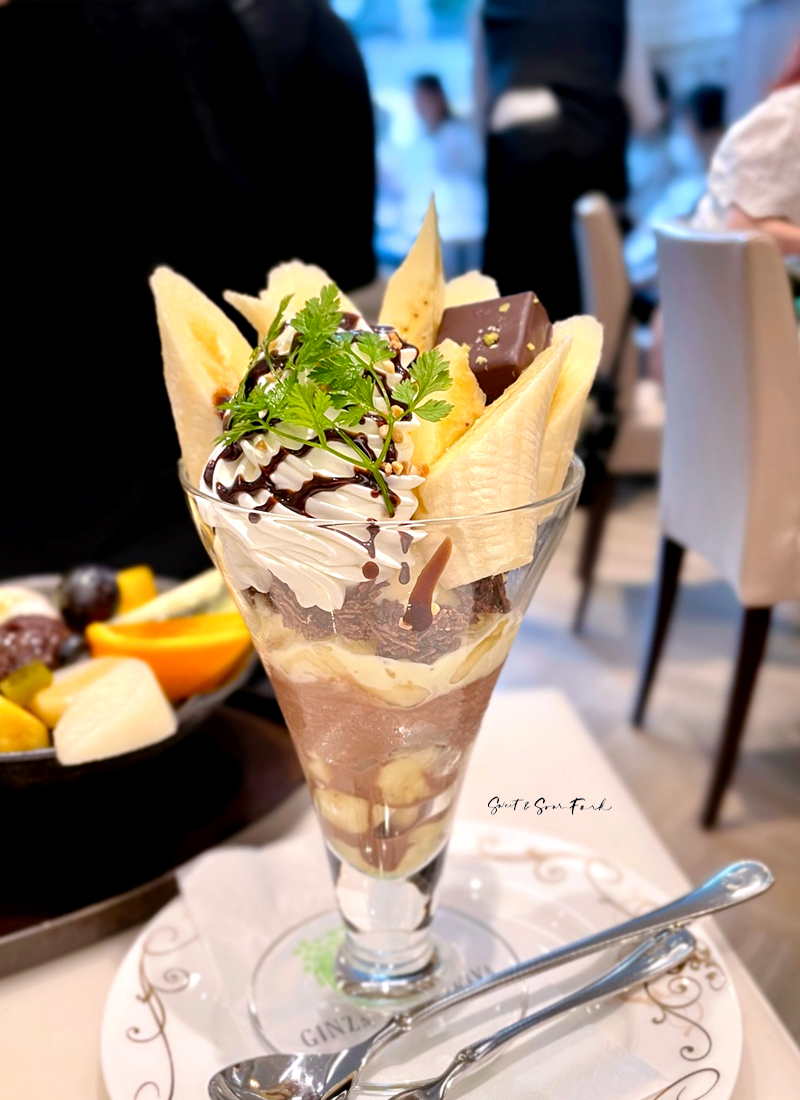
Chocolate and Banana Parfait (1980 yen)
After the fanciness at Ginza Sembikiya, I relented and agreed that Chris could get a Chocolate and Banana Parfait (1980 yen). Though nothing you can’t make at home, it’s hard to deny the attractiveness of the banana, cream, and chocolate combination. I was especially fond of the crunchy bits mixed through, as well as the excellent chocolate praline topper.

Fruits Anmitsu (1760 yen)
With the aim of doing justice to the longstanding fruit purveyor, I decided to try the Fruits Anmitsu (1760 yen), which is a platter of seasonal fruit and Japanese sweets, with a side of brown sugar syrup for drizzling. And honestly, although the fruit is of good quality, it’s once again no better than in-season produce you get in Australia. I did however enjoy the smooth, rich vanilla ice cream, and chewy Japanese sweets are always a win in my books.
Miscellaneous Good Stuff

Toromasa
I was desperate to try out a real-deal izakaya whilst I was in Japan, and late one evening (after a day at DisneySea), we wandered into Toromasa in Ginza, which seemed to have a good crowd and a decent menu. As it turns out, unlike in Australia, where the izakaya is about tasty nibbles as well as Japanese drinks, izakayas in Japan are basically the equivalent of a local pub. The drinks are cheap, but the food is both ordinary and… not expensive, but not cheap either. At least, that was my impression of the ones we looked in on. We ordered a small selection of dishes, none of which were very inspiring, and basically got out of there before too long. Though I am very impressed with the number of corporate workers ordering endless rounds on a weeknight at 11pm.

A’telier du Pain
Japanese bakeries on the other hand, are a completely different deal. Every other street corner is home to a patisserie, and even though we had just eaten a gut-busting meal at Fuunji, I couldn’t help but get a few things at A’telier Du Pain. The best of the lot was the Rum Fig and Cream Cheese (324 yen) – a dense, yeasty bread studded with walnuts, and filled with fig and cream cheese. It is elegant, delicious, and filling. The Pistachio Canelé (399 yen) would obviously have been better fresh from the oven, but it had all the right elements, including a lightly caramelised, chewy-crisp shell, and a custardy centre. And finally, a piece of French Toast (226 yen), which is not so much what we think of it as a piece of eggy, corn-flavoured bread. Still tasty though.

Dango (400 yen)/Matcha (200 yen)
Senso-ji is a gorgeous place in Tokyo to visit, even if it is thronged with both locals and tourists around the year. And if you don’t mind the crowds, there’s also quite a bit of good stuff to eat as well. I couldn’t help but feel rather transported as I chowed down on a snack of fresh, chewy Dango (400 yen), chased by a glass of ice-cold Matcha (200 yen) from Kibidango Azuma. It really does immerse you in the traditional Japanese experience.

Melon Pan (280 yen)
Walk a couple streets down, and you’ll come across Kagetsudo, a famous shop specialising in Melon Pan (280 yen). The aroma of sugar and butter hits in a warm wave, and smells better than the best Asian bakery. I’m usually not a fan of melon pan, feeling that it’s rather boring. But this changed my mind completely. Piping hot from the oven, the lightly sweetened milk bun is impossibly fluffy. Baked into the top is a crust of sugary cookie dough, its crunchy, caramelised sweetness contrasting gloriously with bread so airy that it deflates in the hand. These may be enormous, but boy do they go down easy.

Strawberry Cream Cheesecake Crepe (630 yen)
When in Harajuku, right? Because crepes are a must-have when walking down this well-known street, we stopped at Marion Crepes for a Strawberry Cream Cheesecake Crepe (630 yen). Super thin and light, this warm crepe is stuffed full of sugary, creamy goodness, and the fresh strawberries provided a welcome brightness.

Custard Taiyaki (240 yen)
Not far from out hotel was Taiyaki Kanda Daruma, which seems perpetually popular. Made fresh to order, the Custard Taiyaki (240 yen) was indeed worth waiting for, with its centre of thick, sweet vanilla custard, encased in a light batter reminiscent of a warm waffle cone.
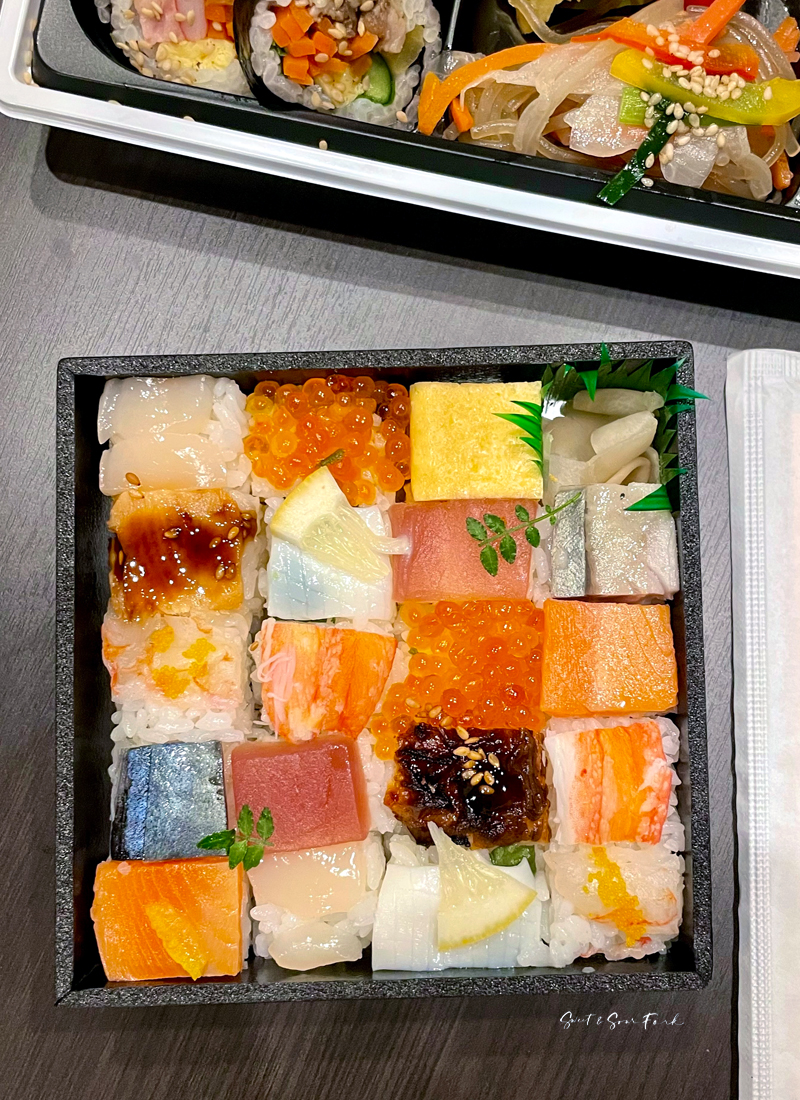
Sushi Bento (1188 yen)

Korean Bento (991 yen)
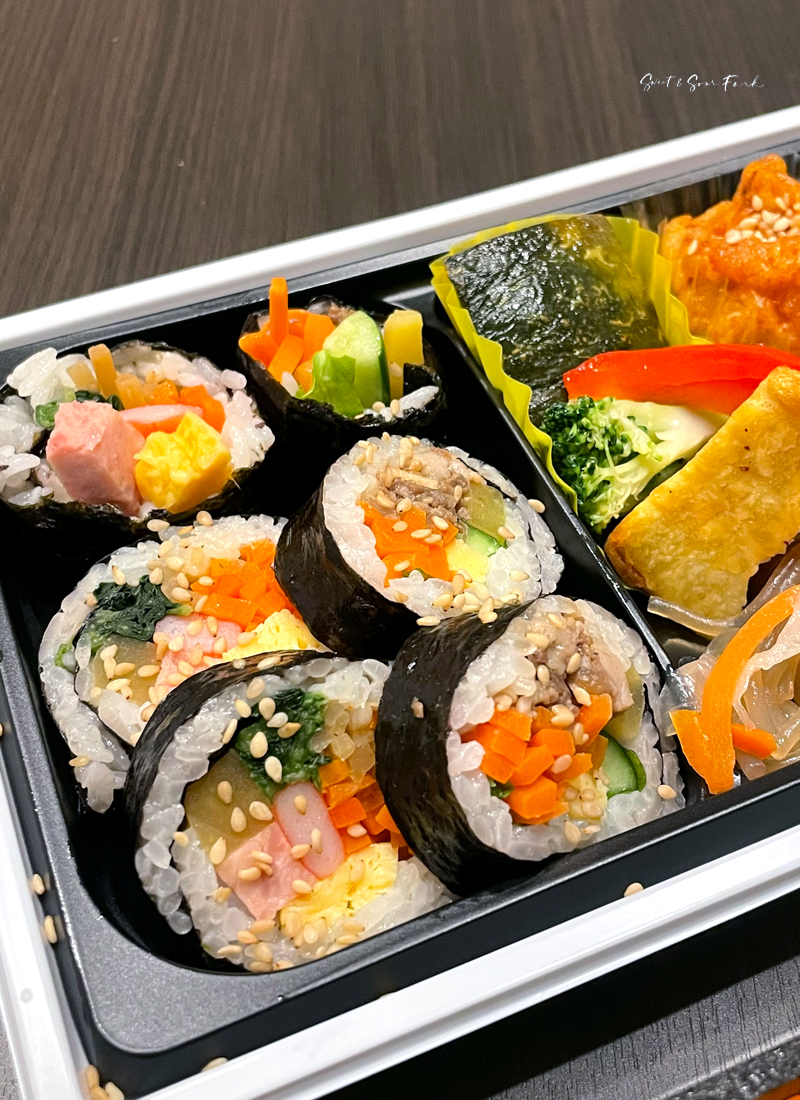
Korean Bento (991 yen)

Korean Bento (991 yen)
Everyone knows that konbini, aka Japanese convenience stores, are an excellent place to get a quality cheap meal on the go. But a little less well known is the existence of depachika – department store food courts which are a veritable cornucopia of cooked dishes, produce, and gourmet food gifts. Take the above for example – we got a Sushi Bento (1188 yen) and a Korean Bento (991 yen) at Shibuchika and yes, it all tasted as good as it looked. Definitely a great option to keep in mind if you want something more meal-like compared to the local 7-11, but really can’t be bothered going out.

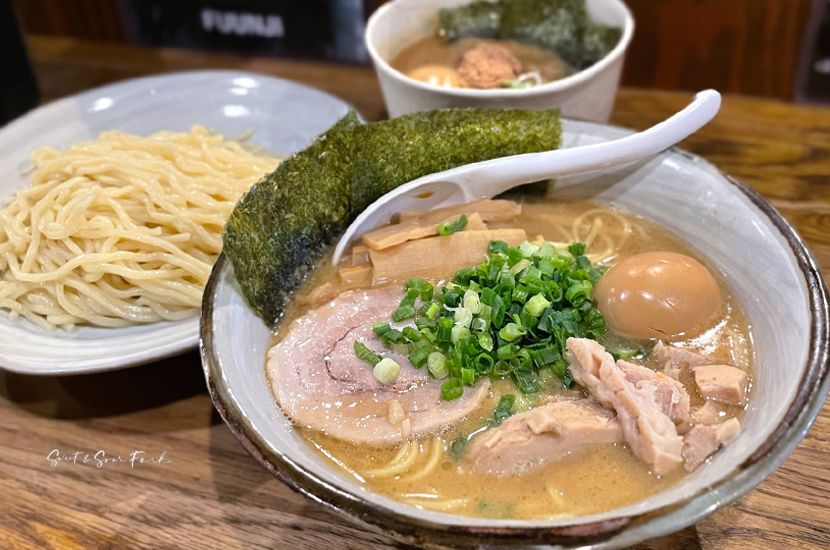
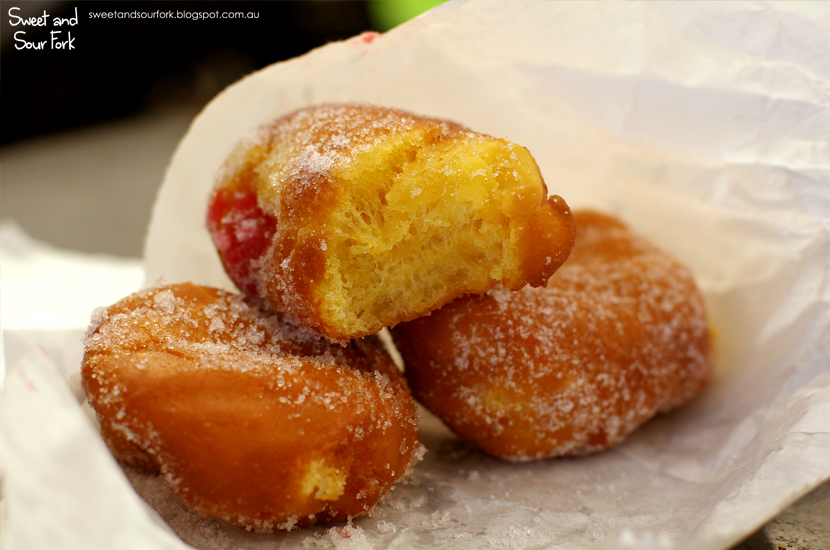
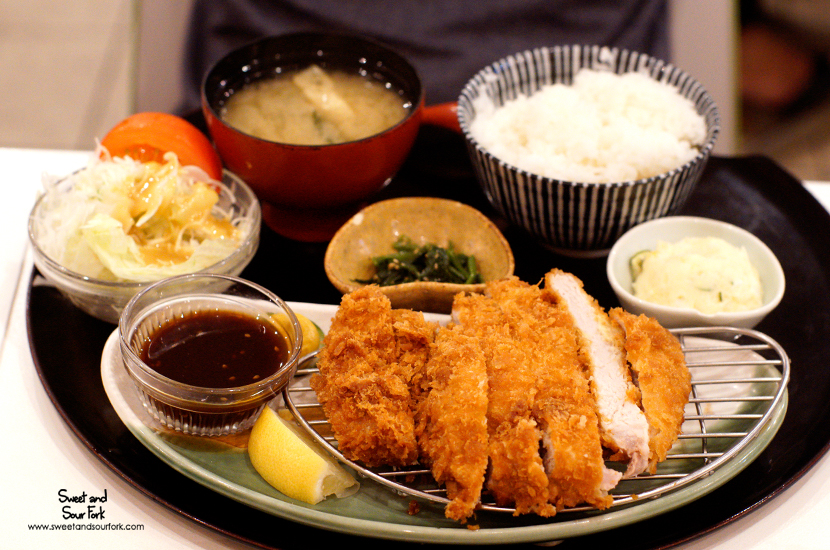
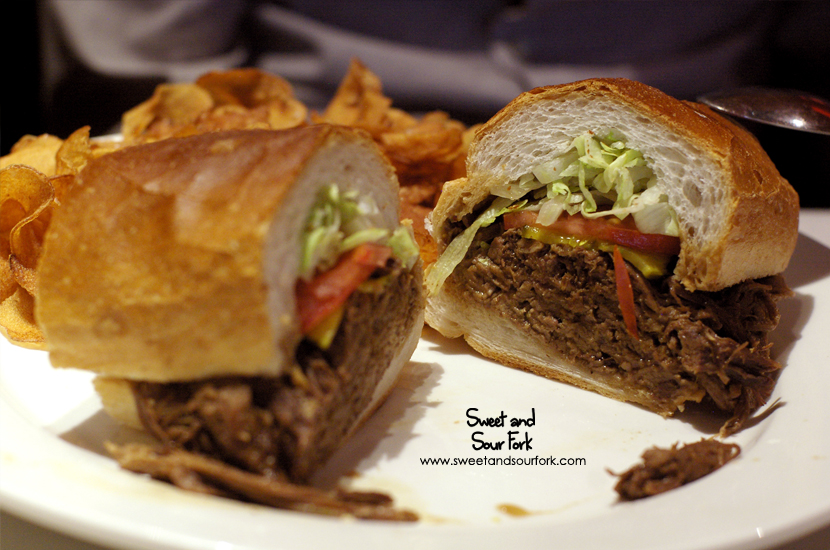
No Comments